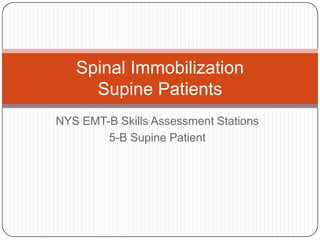Spinal immobilization supine
•Download as PPTX, PDF•
3 likes•1,198 views
This document provides instructions for properly applying a cervical collar during an EMT skills assessment station involving spinal immobilization of a supine patient. Key steps include placing the chin support under the chin and adjusting the size if needed, pulling the back of the collar snug while holding the front in place and fastening it, and for a supine patient, sliding the rear panel behind the neck before placing the chin support. It also notes that cannula hooks are provided for securing supplemental oxygen lines and that the scenario involves immobilizing an unstable spine using a long spine device with the help of an assistant EMT and evaluator.
Report
Share
Report
Share

Recommended
More Related Content
What's hot
What's hot (20)
Case Review #50: 29 year old woman presents with dislodged instrumentation fo...

Case Review #50: 29 year old woman presents with dislodged instrumentation fo...
Case Review #6: 53 year old woman with Adult Scoliosis

Case Review #6: 53 year old woman with Adult Scoliosis
Case Review #8: A 29 year old female firefigher presented with Scheurmanns Ky...

Case Review #8: A 29 year old female firefigher presented with Scheurmanns Ky...
Postoperative care of femoral shaft and supracondylar fx

Postoperative care of femoral shaft and supracondylar fx
Workshop: Orthopedic Management in Emergency Department

Workshop: Orthopedic Management in Emergency Department
Case Review #5: 48 year old male with Scheurmann's Kyphosis

Case Review #5: 48 year old male with Scheurmann's Kyphosis
Case Review #42: 39 year old female with Adult Congenital Scoliosis

Case Review #42: 39 year old female with Adult Congenital Scoliosis
Case Review #11: Progressive Adolescent Idiopathic Scoliosis

Case Review #11: Progressive Adolescent Idiopathic Scoliosis
Case Review #22: 21 year old with Progressive Adolescent Idiopathic Scoliosis

Case Review #22: 21 year old with Progressive Adolescent Idiopathic Scoliosis
Case Review #15: 13 year old female with Profressive Adolescent Idiopathic Sc...

Case Review #15: 13 year old female with Profressive Adolescent Idiopathic Sc...
Case Review #12: 14 Year Old Female with Adolescent Idiopathic Scoliosis

Case Review #12: 14 Year Old Female with Adolescent Idiopathic Scoliosis
Case Review #14: 16 year old female with progressive adolescent scoliosis

Case Review #14: 16 year old female with progressive adolescent scoliosis
Case Review #13: 50 year old female with progressive Adult Idiopathic Scoliosis

Case Review #13: 50 year old female with progressive Adult Idiopathic Scoliosis
Case Review #10: 12 year old girl with 70 degree Scoliosis 

Case Review #10: 12 year old girl with 70 degree Scoliosis
Viewers also liked
Viewers also liked (20)
Standing 101 (Standing Therapy for the People with Disabilities)

Standing 101 (Standing Therapy for the People with Disabilities)
It's time to do away with the hard Cervical Collar

It's time to do away with the hard Cervical Collar
Cervical Spine Clearance in Trauma for Moderate Resource Settings

Cervical Spine Clearance in Trauma for Moderate Resource Settings
Similar to Spinal immobilization supine
Similar to Spinal immobilization supine (20)
Adult Orthopedic Imaging Series: Presentation #2 Native Hip Dislocations

Adult Orthopedic Imaging Series: Presentation #2 Native Hip Dislocations
USG guidance for supracondylar fracture of humerus

USG guidance for supracondylar fracture of humerus
very important first aid skills neurosurgical overview.ppt

very important first aid skills neurosurgical overview.ppt
Spinal immobilization supine
- 1. NYS EMT-B Skills Assessment Stations 5-B Supine Patient Spinal Immobilization Supine Patients
- 2. Properly Applying a ‘Collar’
- 3. Properly Applying a ‘Collar’
- 4. Properly Applying a ‘Collar’
- 5. Properly Applying a ‘Collar’ Place the chin support under the chin. If a different size is needed, remove, resize, and re-apply the collar. Pull the back of the collar snug while holding the front in place, and then fasten
- 6. Properly Applying a ‘Collar’ For a supine patient, slide the rear panel behind the neck before placing the chin support
- 7. Properly Applying a ‘Collar’ Cannula hooks are provided for the securement of supplemental oxygen lines.
- 8. Alternatives to a Collar
- 9. The Scenario This station is designed to test your ability to provide spinal immobilization on a patient using a long spine immobilization device. You and an EMT assistant arrive on the scene of an automobile crash. The scene is safe and there is only one patient. The assistant EMT has completed the initial assessment and no critical condition requiring intervention was found. For the purpose of this station, the patient’s vital signs remain stable. You are required to treat the specific, isolated problem of an unstable spine using a long spine immobilization device. When moving the patient to the device, you should use the help of the assistant EMT and the evaluator. The assistant EMT should control the head and cervical spine of the patient while you and the evaluator move the patient to the immobilization device. You are responsible for the direction and subsequent action of the EMT assistant. You may use any equipment available in this room. You have ten (10) minutes to complete this station. Do you have any questions?
- 10. The Skill Sheet
- 11. The Skill Sheet